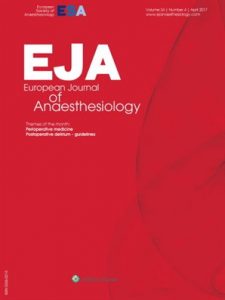 The editors of an anesthesiology journal have retracted a paper about predicting how patients will respond to a procedure, after the results of an investigation cast doubt on the validity and originality of the work.
The editors of an anesthesiology journal have retracted a paper about predicting how patients will respond to a procedure, after the results of an investigation cast doubt on the validity and originality of the work.
According to the retraction notice, the editors became concerned about the validity of the data and conducted an investigation, which found irregularities, “including misrepresentation of results.” Because the authors could not provide adequate evidence to assuage these concerns, the editors decided to retract the paper.
The paper — about which facial muscles best predict if a patient is ready to be intubated — had already been flagged on F1000: A few years ago, two anesthesiologists from Florida commented that they found the article “confusing,” and felt that the authors “did not prove their hypothesis.”
Here’s the retraction notice for “Comparison of four facial muscles, orbicularis oculi, corrugator supercilii, masseter or mylohyoid, as best predictor of good conditions for intubation: A randomised blinded trial,” published in the European Journal of Anaesthesiology in 2013 and cited once:
Concerns have been raised regarding the validity of the data presented in the article, ‘Comparison of four facial muscles, orbicularis oculi, corrugator supercilii, masseter or mylohyoid, as best predictor of good conditions for intubation: A randomised blinded trial’. A subsequent investigation was conducted by the Editors of the European Journal of Anaesthesiology, with collaboration from external reviewers, and the results of the investigation found irregularities in their data, including misrepresentation of results, from which this article was derived. The authors have been unable to provide convincing evidence that their study had been conducted according to international standards, that all reported data are original, and that the analyses are valid. On the basis of this investigation the Editors of the European Journal of Anaesthesiology strongly supports retraction. The article is retracted.
To find out more about the investigation and irregularities, we contacted the journal’s editor-in-chief Martin R. Tramèr, from the Hôpitaux Universitaires de Genève and the publisher, Wolters Kluwer. We also reached out to several of the authors—corresponding author Kyo Sang Kim from Hanyang University Hospital in Seoul, Korea, as well as first author Hee Jong Lee and third author Ji Seon Jeong.
Here’s more from the F1000 comment by two anesthesiologists from the University of Florida College of Medicine, expressing their concerns about the study:
The present study was designed to verify which of four different facial muscles — the orbicularis oculi, corrugator supercilii, masseter or the mylohyoid — is the best predictor of readiness to intubate successfully following the administration of rocuronium. However, I found the article very confusing and not easy to read. I failed to understand why the authors used two different doses of the muscle relaxant, and I failed to understand what the authors mean by all the terms they used to describe ‘conditions at intubation’. In my opinion, they did not prove their hypothesis and rather proved that doubling the dose of rocuronium meant the intubating conditions were achieved faster.
We’ll update the post if we hear back from the journal or authors.
One of the anesthesiologists who posted the F1000 comment is Felipe Urdaneta. After Urdaneta’s 2004 paper was retracted, the journal editor’s response prompted one of our most memorable posts, when he told us the reason why the paper was pulled was “none of your damn business.”
The other author of the comment, Nikolaus Gravenstein, is a well-known anesthesiologist whose father was also quite influential in the same field.
Like Retraction Watch? Consider making a tax-deductible contribution to support our growth. You can also follow us on Twitter, like us on Facebook, add us to your RSS reader, sign up on our homepage for an email every time there’s a new post, or subscribe to our new daily digest. Click here to review our Comments Policy. For a sneak peek at what we’re working on, click here.